Microeconomics Assignment: Externalities and Market Failure
VerifiedAdded on 2022/10/10
|6
|1159
|73
Homework Assignment
AI Summary
This economics assignment explores several key concepts in microeconomics. It begins by defining market failure and explaining the role of Pigovian taxes in correcting negative externalities, specifically using the example of car driving and its external costs. The solution illustrates this with a graphical representation. The assignment then delves into the characteristics of public goods and why the private sector struggles to provide them, using lighthouses as an example. It also examines common property resources, focusing on the challenges of preventing overfishing in Canada's fisheries and discussing potential policy solutions like licensing fees. Finally, the assignment addresses the claims made by media regarding tax rates for high-income and low-income earners, explaining the differences between lump-sum tax systems and marginal tax rates in the Canadian context. The solution provides detailed explanations, definitions, and examples to illustrate each concept.
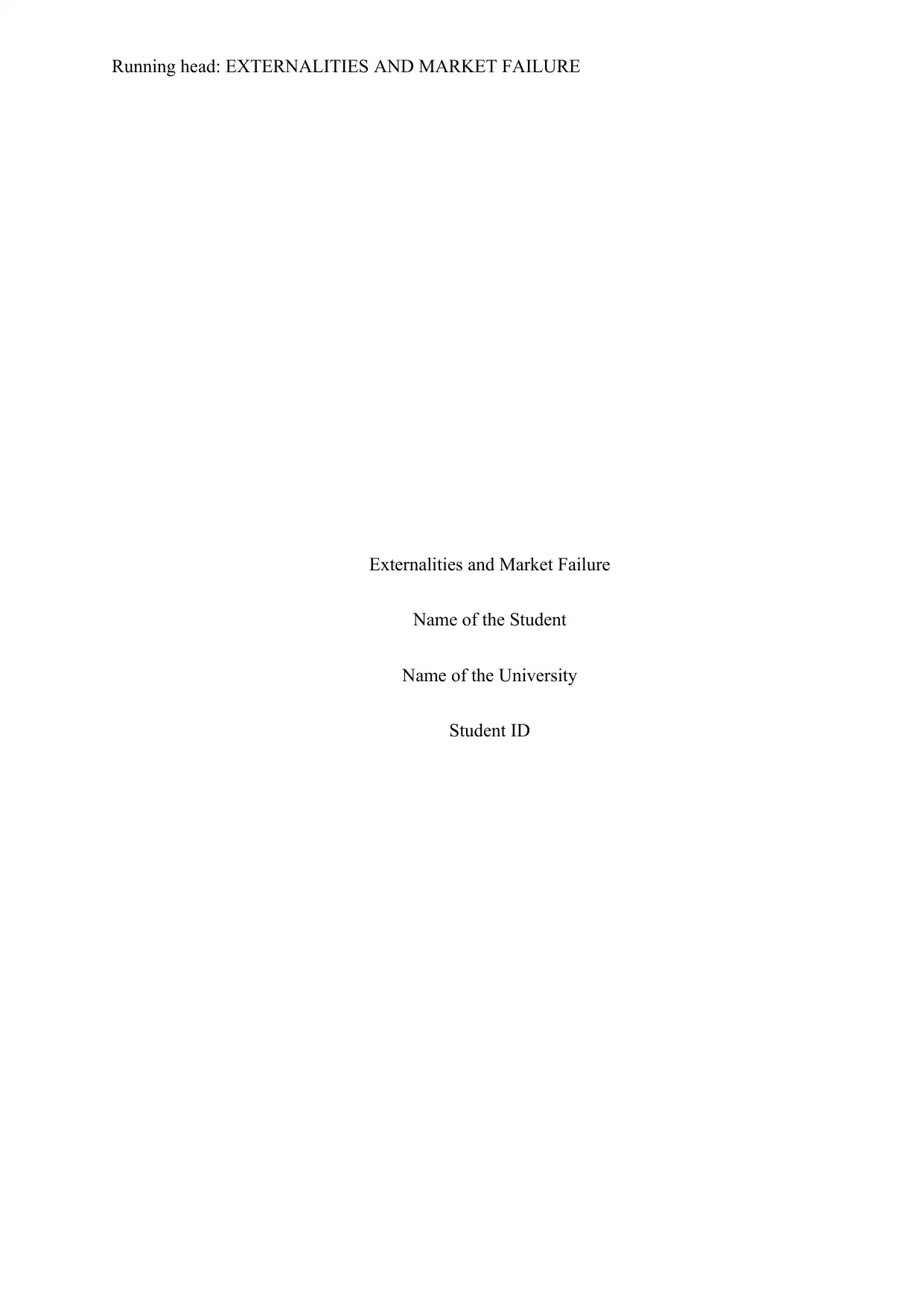
Running head: EXTERNALITIES AND MARKET FAILURE
Externalities and Market Failure
Name of the Student
Name of the University
Student ID
Externalities and Market Failure
Name of the Student
Name of the University
Student ID
Paraphrase This Document
Need a fresh take? Get an instant paraphrase of this document with our AI Paraphraser
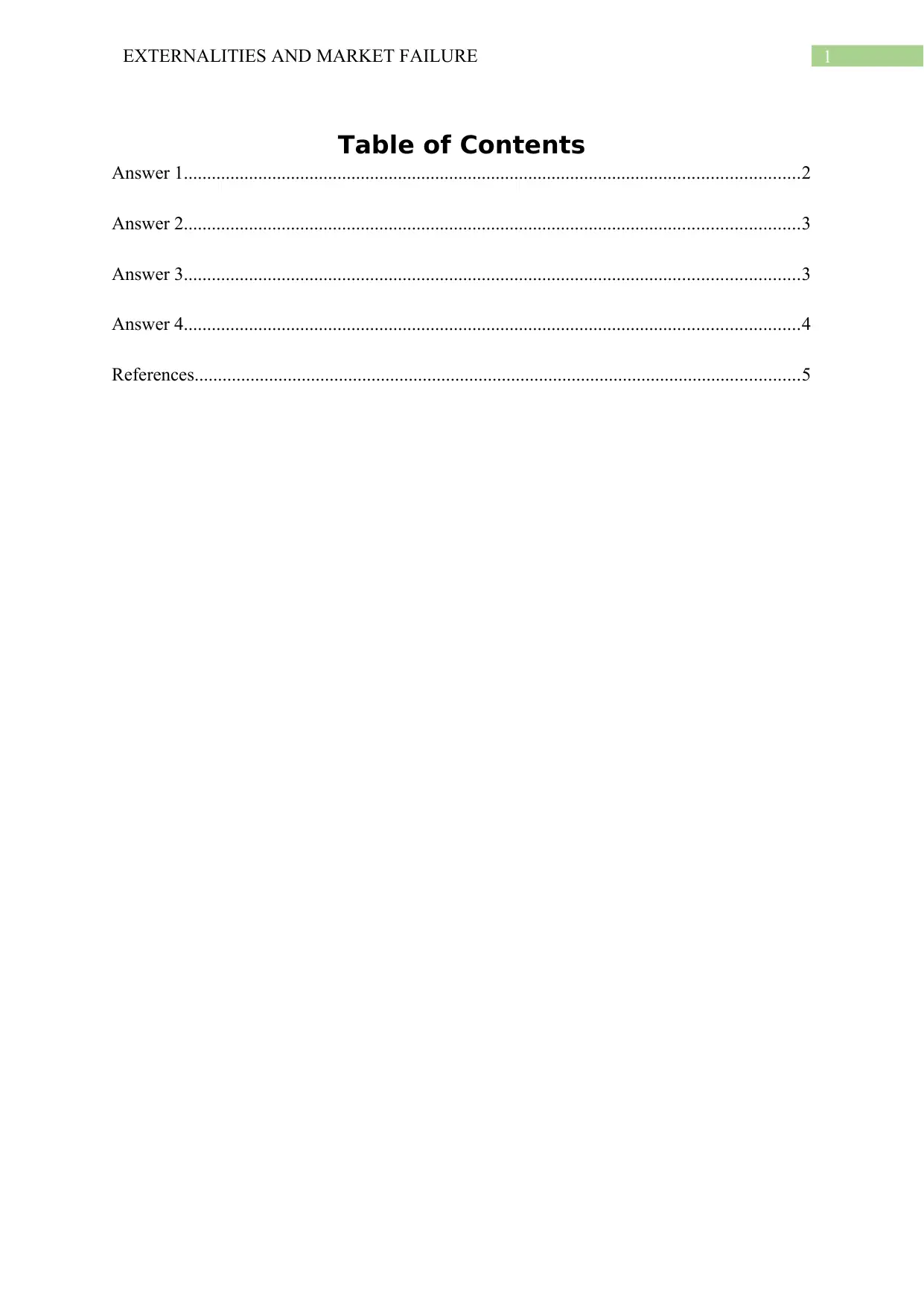
1EXTERNALITIES AND MARKET FAILURE
Table of Contents
Answer 1....................................................................................................................................2
Answer 2....................................................................................................................................3
Answer 3....................................................................................................................................3
Answer 4....................................................................................................................................4
References..................................................................................................................................5
Table of Contents
Answer 1....................................................................................................................................2
Answer 2....................................................................................................................................3
Answer 3....................................................................................................................................3
Answer 4....................................................................................................................................4
References..................................................................................................................................5
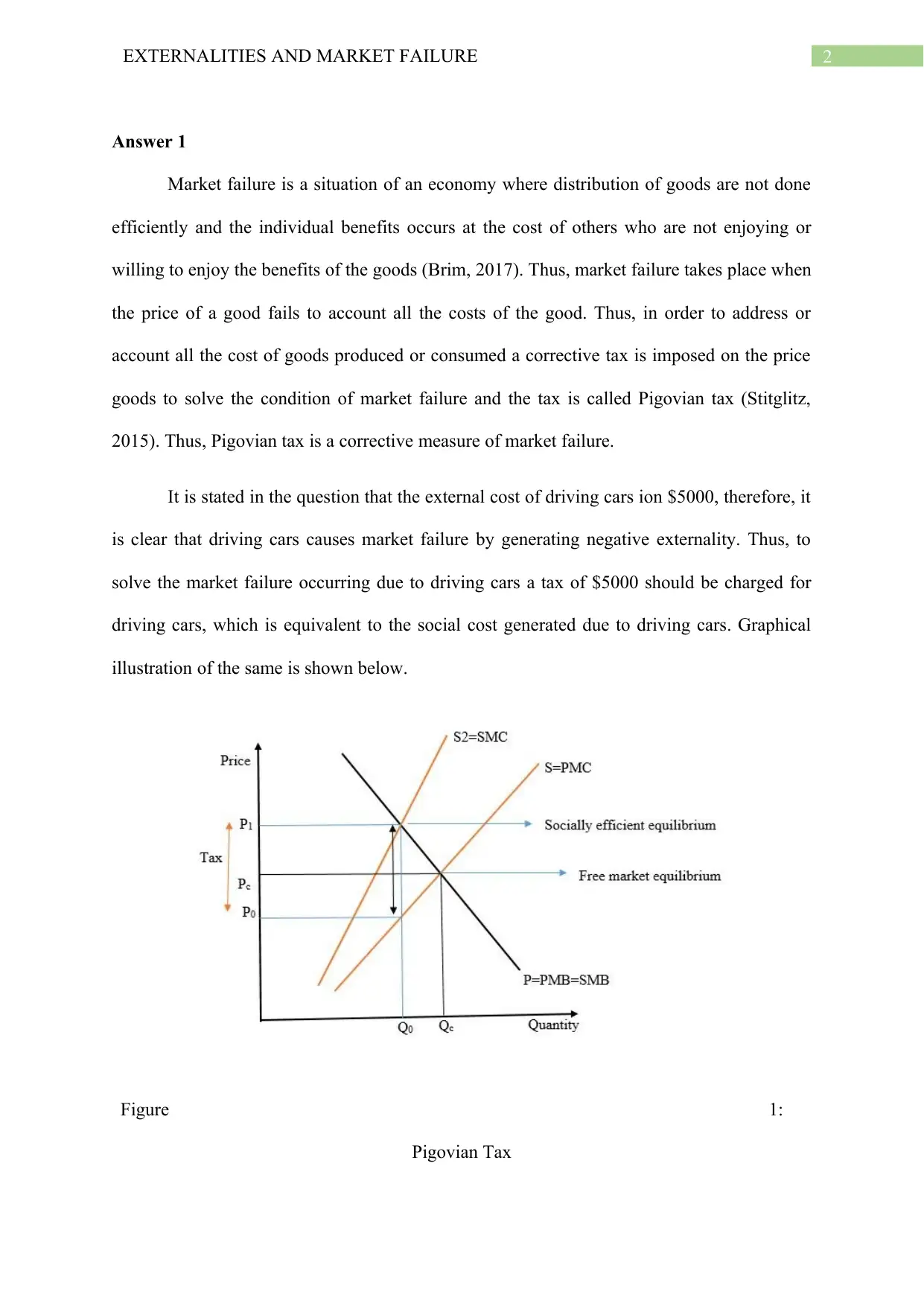
2EXTERNALITIES AND MARKET FAILURE
Answer 1
Market failure is a situation of an economy where distribution of goods are not done
efficiently and the individual benefits occurs at the cost of others who are not enjoying or
willing to enjoy the benefits of the goods (Brim, 2017). Thus, market failure takes place when
the price of a good fails to account all the costs of the good. Thus, in order to address or
account all the cost of goods produced or consumed a corrective tax is imposed on the price
goods to solve the condition of market failure and the tax is called Pigovian tax (Stitglitz,
2015). Thus, Pigovian tax is a corrective measure of market failure.
It is stated in the question that the external cost of driving cars ion $5000, therefore, it
is clear that driving cars causes market failure by generating negative externality. Thus, to
solve the market failure occurring due to driving cars a tax of $5000 should be charged for
driving cars, which is equivalent to the social cost generated due to driving cars. Graphical
illustration of the same is shown below.
Figure 1:
Pigovian Tax
Answer 1
Market failure is a situation of an economy where distribution of goods are not done
efficiently and the individual benefits occurs at the cost of others who are not enjoying or
willing to enjoy the benefits of the goods (Brim, 2017). Thus, market failure takes place when
the price of a good fails to account all the costs of the good. Thus, in order to address or
account all the cost of goods produced or consumed a corrective tax is imposed on the price
goods to solve the condition of market failure and the tax is called Pigovian tax (Stitglitz,
2015). Thus, Pigovian tax is a corrective measure of market failure.
It is stated in the question that the external cost of driving cars ion $5000, therefore, it
is clear that driving cars causes market failure by generating negative externality. Thus, to
solve the market failure occurring due to driving cars a tax of $5000 should be charged for
driving cars, which is equivalent to the social cost generated due to driving cars. Graphical
illustration of the same is shown below.
Figure 1:
Pigovian Tax
⊘ This is a preview!⊘
Do you want full access?
Subscribe today to unlock all pages.

Trusted by 1+ million students worldwide
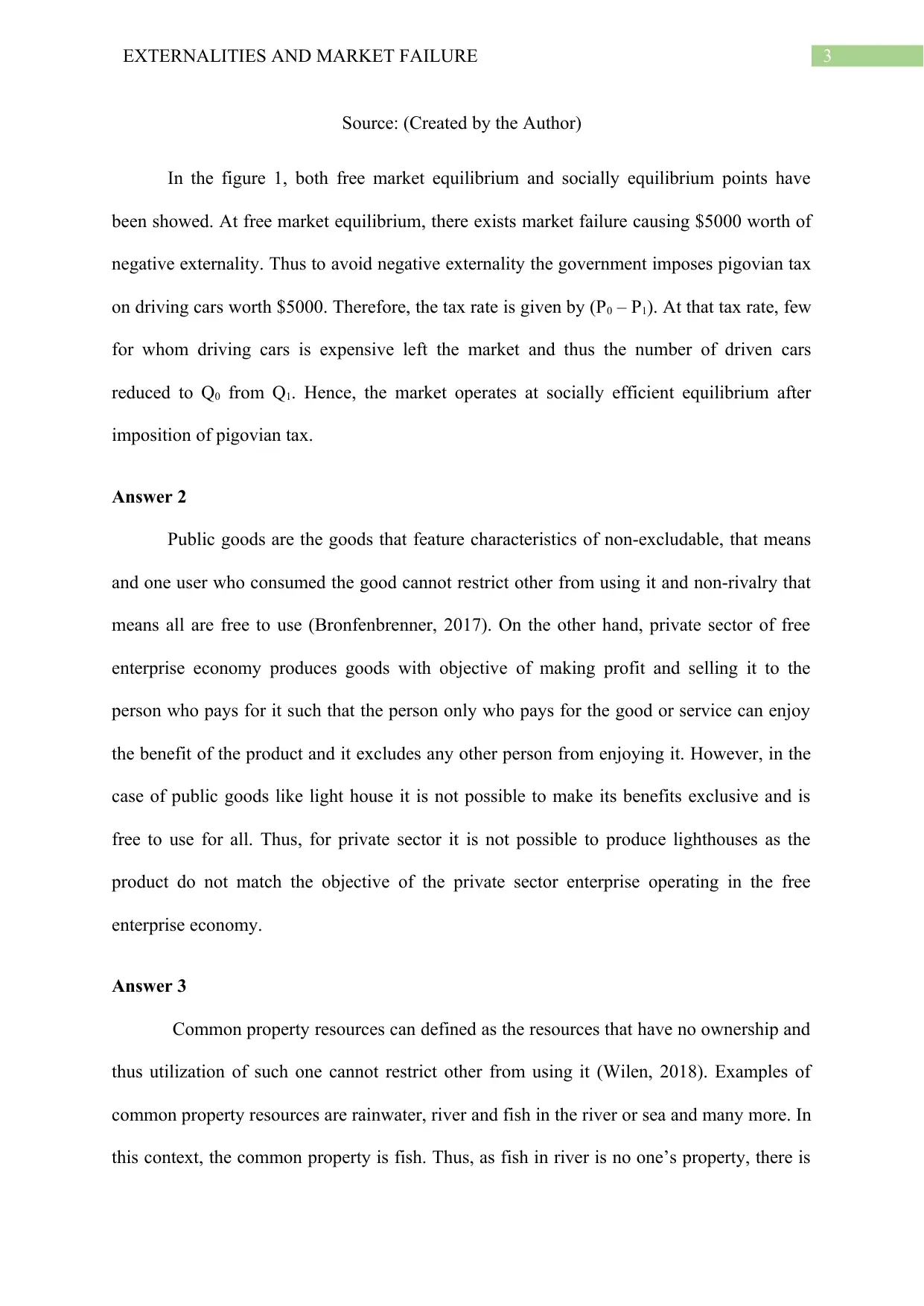
3EXTERNALITIES AND MARKET FAILURE
Source: (Created by the Author)
In the figure 1, both free market equilibrium and socially equilibrium points have
been showed. At free market equilibrium, there exists market failure causing $5000 worth of
negative externality. Thus to avoid negative externality the government imposes pigovian tax
on driving cars worth $5000. Therefore, the tax rate is given by (P0 – P1). At that tax rate, few
for whom driving cars is expensive left the market and thus the number of driven cars
reduced to Q0 from Q1. Hence, the market operates at socially efficient equilibrium after
imposition of pigovian tax.
Answer 2
Public goods are the goods that feature characteristics of non-excludable, that means
and one user who consumed the good cannot restrict other from using it and non-rivalry that
means all are free to use (Bronfenbrenner, 2017). On the other hand, private sector of free
enterprise economy produces goods with objective of making profit and selling it to the
person who pays for it such that the person only who pays for the good or service can enjoy
the benefit of the product and it excludes any other person from enjoying it. However, in the
case of public goods like light house it is not possible to make its benefits exclusive and is
free to use for all. Thus, for private sector it is not possible to produce lighthouses as the
product do not match the objective of the private sector enterprise operating in the free
enterprise economy.
Answer 3
Common property resources can defined as the resources that have no ownership and
thus utilization of such one cannot restrict other from using it (Wilen, 2018). Examples of
common property resources are rainwater, river and fish in the river or sea and many more. In
this context, the common property is fish. Thus, as fish in river is no one’s property, there is
Source: (Created by the Author)
In the figure 1, both free market equilibrium and socially equilibrium points have
been showed. At free market equilibrium, there exists market failure causing $5000 worth of
negative externality. Thus to avoid negative externality the government imposes pigovian tax
on driving cars worth $5000. Therefore, the tax rate is given by (P0 – P1). At that tax rate, few
for whom driving cars is expensive left the market and thus the number of driven cars
reduced to Q0 from Q1. Hence, the market operates at socially efficient equilibrium after
imposition of pigovian tax.
Answer 2
Public goods are the goods that feature characteristics of non-excludable, that means
and one user who consumed the good cannot restrict other from using it and non-rivalry that
means all are free to use (Bronfenbrenner, 2017). On the other hand, private sector of free
enterprise economy produces goods with objective of making profit and selling it to the
person who pays for it such that the person only who pays for the good or service can enjoy
the benefit of the product and it excludes any other person from enjoying it. However, in the
case of public goods like light house it is not possible to make its benefits exclusive and is
free to use for all. Thus, for private sector it is not possible to produce lighthouses as the
product do not match the objective of the private sector enterprise operating in the free
enterprise economy.
Answer 3
Common property resources can defined as the resources that have no ownership and
thus utilization of such one cannot restrict other from using it (Wilen, 2018). Examples of
common property resources are rainwater, river and fish in the river or sea and many more. In
this context, the common property is fish. Thus, as fish in river is no one’s property, there is
Paraphrase This Document
Need a fresh take? Get an instant paraphrase of this document with our AI Paraphraser
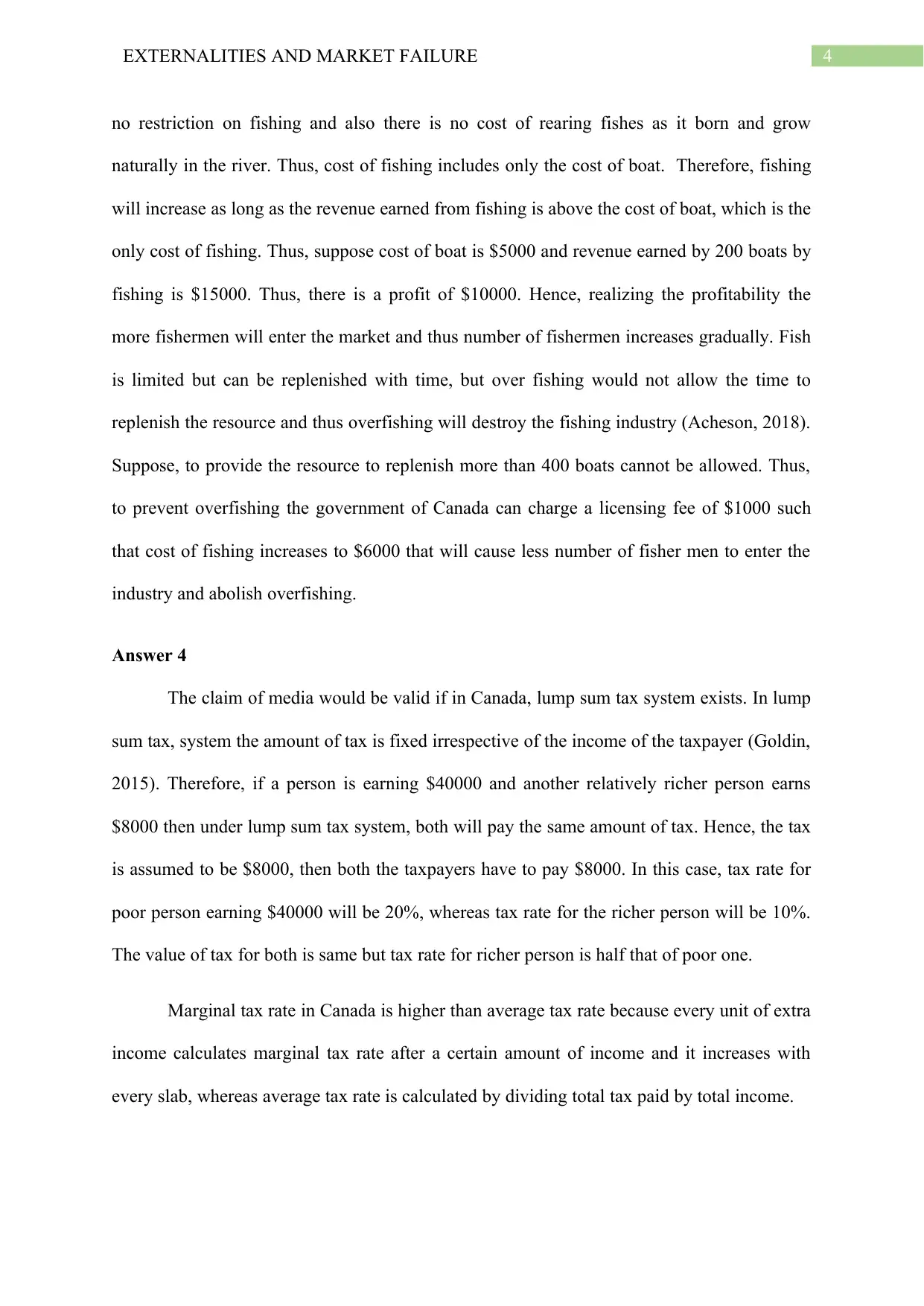
4EXTERNALITIES AND MARKET FAILURE
no restriction on fishing and also there is no cost of rearing fishes as it born and grow
naturally in the river. Thus, cost of fishing includes only the cost of boat. Therefore, fishing
will increase as long as the revenue earned from fishing is above the cost of boat, which is the
only cost of fishing. Thus, suppose cost of boat is $5000 and revenue earned by 200 boats by
fishing is $15000. Thus, there is a profit of $10000. Hence, realizing the profitability the
more fishermen will enter the market and thus number of fishermen increases gradually. Fish
is limited but can be replenished with time, but over fishing would not allow the time to
replenish the resource and thus overfishing will destroy the fishing industry (Acheson, 2018).
Suppose, to provide the resource to replenish more than 400 boats cannot be allowed. Thus,
to prevent overfishing the government of Canada can charge a licensing fee of $1000 such
that cost of fishing increases to $6000 that will cause less number of fisher men to enter the
industry and abolish overfishing.
Answer 4
The claim of media would be valid if in Canada, lump sum tax system exists. In lump
sum tax, system the amount of tax is fixed irrespective of the income of the taxpayer (Goldin,
2015). Therefore, if a person is earning $40000 and another relatively richer person earns
$8000 then under lump sum tax system, both will pay the same amount of tax. Hence, the tax
is assumed to be $8000, then both the taxpayers have to pay $8000. In this case, tax rate for
poor person earning $40000 will be 20%, whereas tax rate for the richer person will be 10%.
The value of tax for both is same but tax rate for richer person is half that of poor one.
Marginal tax rate in Canada is higher than average tax rate because every unit of extra
income calculates marginal tax rate after a certain amount of income and it increases with
every slab, whereas average tax rate is calculated by dividing total tax paid by total income.
no restriction on fishing and also there is no cost of rearing fishes as it born and grow
naturally in the river. Thus, cost of fishing includes only the cost of boat. Therefore, fishing
will increase as long as the revenue earned from fishing is above the cost of boat, which is the
only cost of fishing. Thus, suppose cost of boat is $5000 and revenue earned by 200 boats by
fishing is $15000. Thus, there is a profit of $10000. Hence, realizing the profitability the
more fishermen will enter the market and thus number of fishermen increases gradually. Fish
is limited but can be replenished with time, but over fishing would not allow the time to
replenish the resource and thus overfishing will destroy the fishing industry (Acheson, 2018).
Suppose, to provide the resource to replenish more than 400 boats cannot be allowed. Thus,
to prevent overfishing the government of Canada can charge a licensing fee of $1000 such
that cost of fishing increases to $6000 that will cause less number of fisher men to enter the
industry and abolish overfishing.
Answer 4
The claim of media would be valid if in Canada, lump sum tax system exists. In lump
sum tax, system the amount of tax is fixed irrespective of the income of the taxpayer (Goldin,
2015). Therefore, if a person is earning $40000 and another relatively richer person earns
$8000 then under lump sum tax system, both will pay the same amount of tax. Hence, the tax
is assumed to be $8000, then both the taxpayers have to pay $8000. In this case, tax rate for
poor person earning $40000 will be 20%, whereas tax rate for the richer person will be 10%.
The value of tax for both is same but tax rate for richer person is half that of poor one.
Marginal tax rate in Canada is higher than average tax rate because every unit of extra
income calculates marginal tax rate after a certain amount of income and it increases with
every slab, whereas average tax rate is calculated by dividing total tax paid by total income.
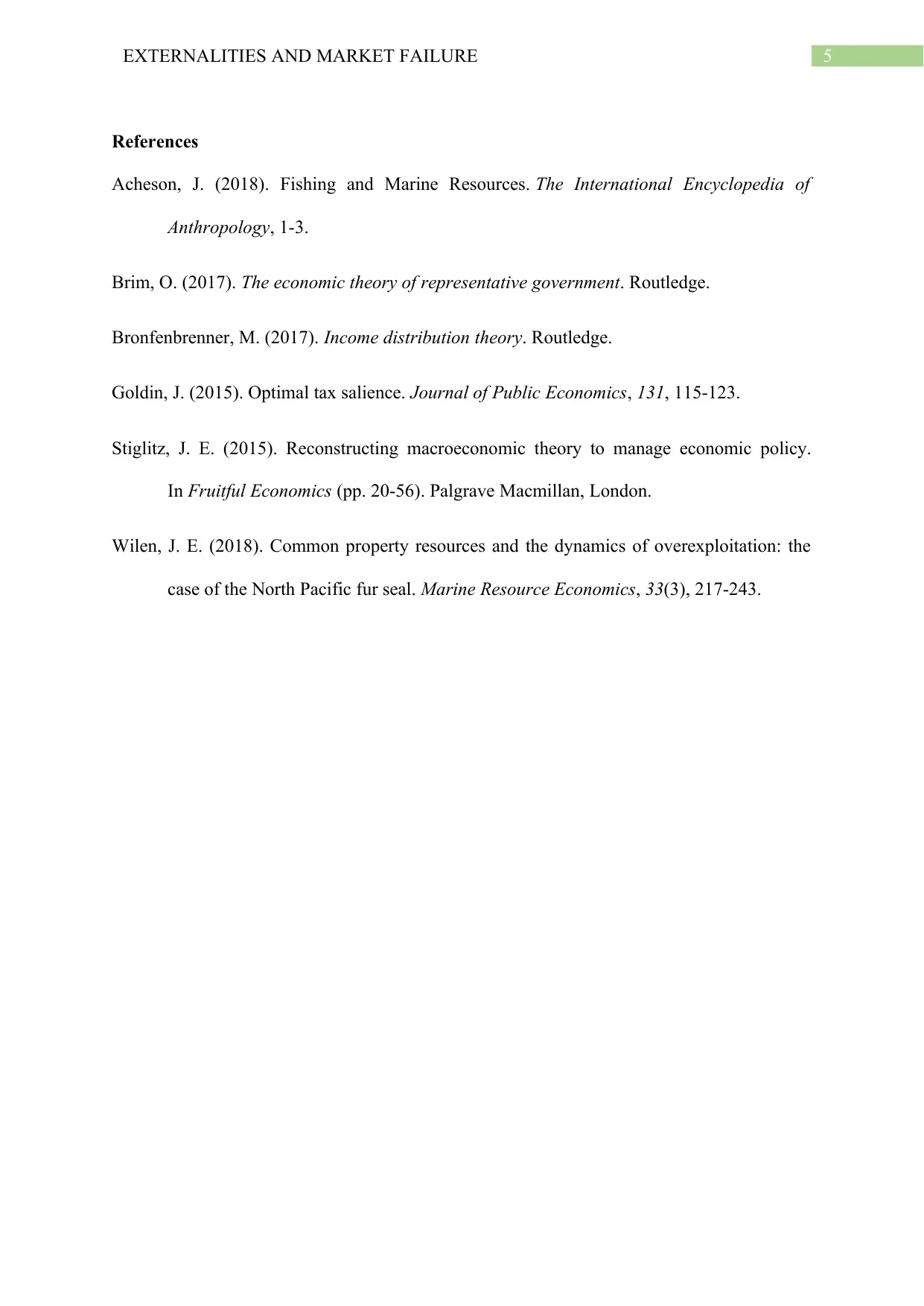
5EXTERNALITIES AND MARKET FAILURE
References
Acheson, J. (2018). Fishing and Marine Resources. The International Encyclopedia of
Anthropology, 1-3.
Brim, O. (2017). The economic theory of representative government. Routledge.
Bronfenbrenner, M. (2017). Income distribution theory. Routledge.
Goldin, J. (2015). Optimal tax salience. Journal of Public Economics, 131, 115-123.
Stiglitz, J. E. (2015). Reconstructing macroeconomic theory to manage economic policy.
In Fruitful Economics (pp. 20-56). Palgrave Macmillan, London.
Wilen, J. E. (2018). Common property resources and the dynamics of overexploitation: the
case of the North Pacific fur seal. Marine Resource Economics, 33(3), 217-243.
References
Acheson, J. (2018). Fishing and Marine Resources. The International Encyclopedia of
Anthropology, 1-3.
Brim, O. (2017). The economic theory of representative government. Routledge.
Bronfenbrenner, M. (2017). Income distribution theory. Routledge.
Goldin, J. (2015). Optimal tax salience. Journal of Public Economics, 131, 115-123.
Stiglitz, J. E. (2015). Reconstructing macroeconomic theory to manage economic policy.
In Fruitful Economics (pp. 20-56). Palgrave Macmillan, London.
Wilen, J. E. (2018). Common property resources and the dynamics of overexploitation: the
case of the North Pacific fur seal. Marine Resource Economics, 33(3), 217-243.
⊘ This is a preview!⊘
Do you want full access?
Subscribe today to unlock all pages.

Trusted by 1+ million students worldwide
1 out of 6
Related Documents
Your All-in-One AI-Powered Toolkit for Academic Success.
+13062052269
info@desklib.com
Available 24*7 on WhatsApp / Email
![[object Object]](/_next/static/media/star-bottom.7253800d.svg)
Unlock your academic potential
Copyright © 2020–2025 A2Z Services. All Rights Reserved. Developed and managed by ZUCOL.





